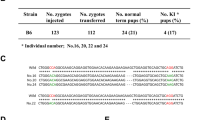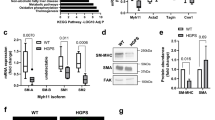Abstract
The major function of vascular smooth muscle cells (SMCs) is contraction to regulate blood pressure and flow. SMC contractile force requires cyclic interactions between SMC α-actin (encoded by ACTA2) and the β-myosin heavy chain (encoded by MYH11). Here we show that missense mutations in ACTA2 are responsible for 14% of inherited ascending thoracic aortic aneurysms and dissections (TAAD). Structural analyses and immunofluorescence of actin filaments in SMCs derived from individuals heterozygous for ACTA2 mutations illustrate that these mutations interfere with actin filament assembly and are predicted to decrease SMC contraction. Aortic tissues from affected individuals showed aortic medial degeneration, focal areas of medial SMC hyperplasia and disarray, and stenotic arteries in the vasa vasorum due to medial SMC proliferation. These data, along with the previously reported MYH11 mutations causing familial TAAD1, indicate the importance of SMC contraction in maintaining the structural integrity of the ascending aorta.
This is a preview of subscription content, access via your institution
Access options
Subscribe to this journal
Receive 12 print issues and online access
$209.00 per year
only $17.42 per issue
Buy this article
- Purchase on SpringerLink
- Instant access to full article PDF
Prices may be subject to local taxes which are calculated during checkout





Similar content being viewed by others
Change history
23 January 2008
In the version of this article initially published, the affiliation for C S Raman was incorrect. Dr. Raman is affiliated with the Department of Biochemistry and Molecular Biology at the University of Texas Health Science Center, and not with the Structural Biology Center. The error has been corrected in the PDF version of the article.
References
Zhu, L. et al. Mutations in myosin heavy chain 11 cause a syndrome associating thoracic aortic aneurysm/aortic dissection and patent ductus arteriosus. Nat. Genet. 38, 343–349 (2006).
Vandekerckhove, J. & Weber, K. At least six different actins are expressed in a higher mammal: an analysis based on the amino acid sequence of the amino-terminal tryptic peptide. J. Mol. Biol. 126, 783–802 (1978).
McHugh, K.M., Crawford, K. & Lessard, J.L. A comprehensive analysis of the developmental and tissue-specific expression of the isoactin multigene family in the rat. Dev. Biol. 148, 442–458 (1991).
Fatigati, V. & Murphy, R.A. Actin and tropomyosin variants in smooth muscles. Dependence on tissue type. J. Biol. Chem. 259, 14383–14388 (1984).
Schildmeyer, L.A. et al. Impaired vascular contractility and blood pressure homeostasis in the smooth muscle alpha-actin null mouse. FASEB J. 14, 2213–2220 (2000).
Pannu, H. et al. MYH11 mutations result in a distinct vascular pathology driven by insulin-like growth factor 1 and angiotensin II. Hum. Mol. Genet. 16, 3453–3462 (2007).
Pannu, H., Avidan, N., Tran-Fadulu, V. & Milewicz, D.M. Genetic basis of thoracic aortic aneurysms and dissections: potential relevance to abdominal aortic aneurysms. Ann. NY Acad. Sci. 1085, 242–255 (2006).
Biddinger, A., Rocklin, M., Coselli, J. & Milewicz, D.M. Familial thoracic aortic dilatations and dissections: a case control study. J. Vasc. Surg. 25, 506–511 (1997).
Loeys, B.L. et al. Aneurysm syndromes caused by mutations in the TGF-β receptor. N. Engl. J. Med. 355, 788–798 (2006).
Guo, D. et al. Familial thoracic aortic aneurysms and dissections: genetic heterogeneity with a major locus mapping to 5q13–14. Circulation 103, 2461–2468 (2001).
Lewis, R.A. & Merin, L.M. Iris flocculi and familial aortic dissection. Arch. Ophthalmol. 113, 1330–1331 (1995).
Bixler, D. & Antley, R.M. Familial aortic dissection with iris anomalies—a new connective tissue disease syndrome? Birth Defects Orig. Artic. Ser. 12, 229–234 (1976).
Finkbohner, R., Johnston, D., Crawford, E.S., Coselli, J. & Milewicz, D.M. Marfan syndrome. Long-term survival and complications after aortic aneurysm repair. Circulation 91, 728–733 (1995).
Dominguez, R. Actin-binding proteins—a unifying hypothesis. Trends Biochem. Sci. 29, 572–578 (2004).
Klenchin, V.A. et al. Trisoxazole macrolide toxins mimic the binding of actin-capping proteins to actin. Nat. Struct. Biol. 10, 1058–1063 (2003).
Page, R., Lindberg, U. & Schutt, C.E. Domain motions in actin. J. Mol. Biol. 280, 463–474 (1998).
Small, J.V. & Gimona, M. The cytoskeleton of the vertebrate smooth muscle cell. Acta Physiol. Scand. 164, 341–348 (1998).
Nowak, K.J. et al. Mutations in the skeletal muscle α-actin gene in patients with actin myopathy and nemaline myopathy. Nat. Genet. 23, 208–212 (1999).
Sparrow, J.C. et al. Muscle disease caused by mutations in the skeletal muscle alpha-actin gene (ACTA1). Neuromuscul. Disord. 13, 519–531 (2003).
Ahmad, F., Seidman, J.G. & Seidman, C.E. The genetic basis for cardiac remodeling. Annu. Rev. Genomics Hum. Genet. 6, 185–216 (2005).
Nowak, K.J. et al. Nemaline myopathy caused by absence of alpha-skeletal muscle actin. Ann. Neurol. 61, 175–184 (2007).
Crawford, K. et al. Mice lacking skeletal muscle actin show reduced muscle strength and growth deficits and die during the neonatal period. Mol. Cell. Biol. 22, 5887–5896 (2002).
Pannu, H. et al. Mutations in transforming growth factor-beta receptor type II cause familial thoracic aortic aneurysms and dissections. Circulation 112, 513–520 (2005).
Geisterfer-Lowrance, A.A. et al. A molecular basis for familial hypertrophic cardiomyopathy: a beta cardiac myosin heavy chain gene missense mutation. Cell 62, 999–1006 (1990).
Tardiff, J.C. Sarcomeric proteins and familial hypertrophic cardiomyopathy: linking mutations in structural proteins to complex cardiovascular phenotypes. Heart Fail. Rev. 10, 237–248 (2005).
Gudbjartsson, D.F., Jonasson, K., Frigge, M.L. & Kong, A. Allegro, a new computer program for multipoint linkage analysis. Nat. Genet. 25, 12–13 (2000).
He, R. et al. Characterization of the inflammatory and apoptotic cells in the aortas of patients with ascending thoracic aortic aneurysms and dissections. J. Thorac. Cardiovasc. Surg. 131, 671–678 (2006).
Poindexter, B.J. Immunofluorescence deconvolution microscopy and image reconstruction of human defensins in normal and burned skin. J. Burns Wounds 4, e7 (2005).
Holmes, K.C., Angert, I., Kull, F.J., Jahn, W. & Schroder, R.R. Electron cryo-microscopy shows how strong binding of myosin to actin releases nucleotide. Nature 425, 423–427 (2003).
Otterbein, L.R., Graceffa, P. & Dominguez, R. The crystal structure of uncomplexed actin in the ADP state. Science 293, 708–711 (2001).
Acknowledgements
The authors are grateful to the families and their physicians involved in this study, to S. Veeraraghavan for help generating the structure panels and to C. Akers for excellent graphic assistance. The following sources provided funding for these studies: RO1 HL62594 (D.M.M.), P50HL083794-01 (D.M.M.), UL1 RR024148 (CTSA), and TexGen Foundation. D.M.M. is a Doris Duke Distinguished Clinical Scientist. C.S.R. is a Pew Scholar. R.A.L. is a Senior Scientific Investigator of Research to Prevent Blindness, New York, New York.
Author information
Authors and Affiliations
Corresponding author
Supplementary information
Supplementary Text and Figures
Supplementary Note, Reference List, Supplementary Tables 1–5, Supplementary Figures 1–3 (PDF 852 kb)
Rights and permissions
About this article
Cite this article
Guo, DC., Pannu, H., Tran-Fadulu, V. et al. Mutations in smooth muscle α-actin (ACTA2) lead to thoracic aortic aneurysms and dissections. Nat Genet 39, 1488–1493 (2007). https://doi.org/10.1038/ng.2007.6
Received:
Accepted:
Published:
Issue Date:
DOI: https://doi.org/10.1038/ng.2007.6
This article is cited by
-
Cardiac manifestations of human ACTA2 variants recapitulated in a zebrafish model
Journal of Human Genetics (2024)
-
Intense impact of IL-1β expressing inflammatory macrophages in acute aortic dissection
Scientific Reports (2024)
-
A yeast based assay establishes the pathogenicity of novel missense ACTA2 variants associated with aortic aneurysms
European Journal of Human Genetics (2024)
-
Diagnosis and treatment of cardiovascular disease in patients with heritable connective tissue disorders or heritable thoracic aortic diseases
Cardiovascular Intervention and Therapeutics (2024)
-
A highly penetrant ACTA2 mutation of thoracic aortic disease
Journal of Cardiothoracic Surgery (2023)




